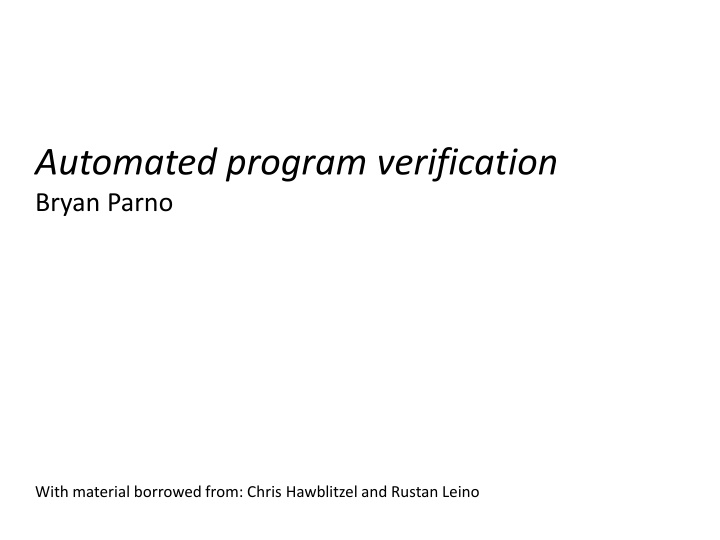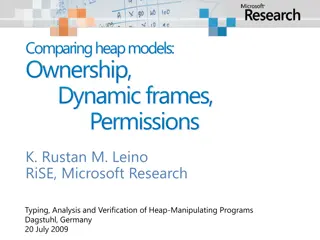
Automated Program Verification and Dafny Overview
Explore the world of automated program verification with Bryan Parno. Learn about tools like Dafny for ensuring program correctness and discover advanced tips. Dive into Hoare logic and various verification methods, including static checking and proof assistants.
Download Presentation

Please find below an Image/Link to download the presentation.
The content on the website is provided AS IS for your information and personal use only. It may not be sold, licensed, or shared on other websites without obtaining consent from the author. If you encounter any issues during the download, it is possible that the publisher has removed the file from their server.
You are allowed to download the files provided on this website for personal or commercial use, subject to the condition that they are used lawfully. All files are the property of their respective owners.
The content on the website is provided AS IS for your information and personal use only. It may not be sold, licensed, or shared on other websites without obtaining consent from the author.
E N D
Presentation Transcript
Automated program verification Bryan Parno With material borrowed from: Chris Hawblitzel and Rustan Leino
Plan Overview Boogie: Hoare logic Dafny: Advanced tips and tricks Reminder: Hw 2 due Friday night. Start early! Questions? 2
Automated program verification Automated Tools try to fill in low-level proof steps Program Focused on verifying the correctness of programs, not necessarily proofs Verification Sound, but not complete Examples Dafny: Imperative, OO F*: ML-like with dependent types 3
Dafny Object-based language generic classes, no subclassing object references, dynamic allocation sequential control Built-in specifications pre- and postconditions framing loop invariants, inline assertions termination Specification support Sets, sequences, algebraic datatypes, coinductive types, integer subset types User-defined functions; higher-order functions Ghost variables Rustan Leino
Types of program verification functional correctness traditional mechanical program verification Dafny extended static checking limited checking automatic decision procedures interactive proof assistants
Demo: Array copy method duplicate(input:array<int>) returns (output:array<int>) 6
Exercise: Concat method concat(a:array<int>, b:array<int>) returns (c:array<int>) requires a != null && b != null; ensures c != null; ensures a[..] + b[..] == c[..]; 7
Dafny code Desired properties Dafny s architecture Implementation How much of this is trusted? Proof Dafny Dafny DafnyCC C# code Boogie code Boogie code BoogieX86 Boogie Boogie Boogie BoogieAsm SMT formulas SMT formulas Asm Z3 Z3 SAT, UNSAT, or Timeout Timeout SAT, UNSAT, or 8
Plan Overview Boogie: Hoare logic Dafny: Advanced tips and tricks 9
Boogie = Intermediate Language for Verification Boogie Verification Debugger Boogie inference SymDiff
Boogie Syntax TYPES primitive types array types t ::= bool | int | bv8 | bv16 | bv32 | real | | [t]t EXPRESSIONS variables boolean expressions | true | false | !e | e && e | e ==> e | ... linear integer arithmetic | ... | -2 | -1 | 0 | 1 | 2 | | e + e | e e | e <= e | ... bit vector arithmetic | e & e | e << e | ... uninterpreted functions| f(e, ,e) arrays | e[e] | e[e := e] quantifiers | (forall x:t :: e) | (exists x:t :: e) e, P ::= x STATEMENTS primitive statementss ::= x := e | assert e; | assume e; | compound statements| s1 s2 | if(e) {s1} else {s2} | while(e) invariant P; {s} |
Hoare logic: Reasoning about imperative code substitute x + 1 for x in x > 5: x + 1 > 5 ? x := x + 1; x > 5 x > 5 x > 4 x := x + 1; initial assumption imperative code goal: prove x > 5 Where does x > 4 come from? Why is it a sufficient assumption to guarantee x > 5 ?
Reasoning about assignment substitute e for x in P P{x := e} x := e; P initial assumption imperative code goal: prove P If we want to ensure that P holds after the assignment to x, we must require that P{x := e} holds before the assignment.
What about more complicated programs? initial assumption y + 3 > 5 x := y; x + 3 > 5 i := 3; x + i > 5 while (i != 0) invariant x + i > 5; { (x + 1) + (i - 1) > 5 i := i - 1; (x + 1) + i > 5 x := x + 1; x + i > 5 } x > 5 substitute y for x substitute 3 for i invariant = induction hypothesis: what we expect to be true at beginning of each loop iteration imperative code substitute i - 1 for i substitute x + 1 for x goal: prove x > 5
What about more complicated programs? y + 3 > 5 x := y; x + 3 > 5 i := 3; x + i > 5 while (i != 0) invariant x + i > 5; { (x + 1) + (i - 1) > 5 i := i - 1; (x + 1) + i > 5 x := x + 1; x + i > 5 } x > 5 proof obligation: assuming i == 0, assuming x + i > 5, prove x > 5 proof obligation: assuming i != 0, assuming x + i > 5, prove (x + 1) + (i - 1) > 5
Hoare logic rules: (P) s (Q) (P) s (Q)describes partial correctness : If P is true for the initial state, and s terminates, then Q will be true for the final state. (P1) s1 (P2) (P2) s2 (P3) ------------------------ (P1) s1 s2 (P3) (P{x := e}) x := e (P) (P && e) assert e; (P) (P) assume e; (P && e) (P && e) s1 (Q) (P && !e) s2 (Q) --------------------------------- (P) if (e) {s1} else {s2} (Q) P ==> P' (P ) s (Q ) Q' ==> Q ----------- (P) s (Q) (I && e) s (I) --------------------------------------------- (I) while(e) invariant I; {s} (I && !e)
Weakest (liberal) precondition If P = wlp(s, Q), then P is in some sense the best (weakest) P such that (P) s (Q). Thus, wlp provides an algorithm for computing P. wlp(x:=y;, x + 3 > 5) = (x + 3 > 5){x := y} = y + 3 > 5 y + 3 > 5 x:=y; x + 3 > 5 i:=3; x + i > 5 wlp(x:=y; i:=3;, x + i > 5) = wlp(x:=y, wlp(i:=3, x + i > 5)) = wlp(x:=y, x + 3 > 5) = y + 3 > 5 wlp(i:=3;, x + i > 5) = (x + i > 5){i := 3} = x + 3 > 5 wlp(x := e, P) = P{x := e} wlp(assert e, P) = e && P wlp(assume e, P) = e ==> P wlp(s1 s2, P) = wlp(s1, wlp(s2, P)) wlp(if(e) {s1} else {s2}, P) = (e ==> wlp(s1, P)) && (!e ==> wlp(s2, P))
Plan Overview Boogie: Hoare logic Dafny: Advanced tips and tricks 18
Dafny tips and caveats Quantifiers and triggers Debugging Controlling function unrolling Sequences Non-linear arithmetic Dynamic frames 20
Reminder: Z3 SMT prover DECIDABLE THEORIES boolean expressions e ::= true | false | !e | e && e | e ==> e | ... linear integer arithmetic e ::= ... | -2 | -1 | 0 | 1 | 2 | e + e | e e | e <= e | ... bit vector arithmetic e ::= ... | e & e | e << e | ... uninterpreted functions e ::= ... | f(e, ,e) arrays e ::= ... | e[e] | e[e := e] MAYBE sequencese ::= ... | [e, ,e] | e + e | e[e..] | e[..e] | e.Length | sets e ::= | {e, ,e} | e U e | {x | e} | e.Count | UNDECIDABLE quantifiers e ::= ... | forall x :: e | exists x :: e nonlinear arithmetic e ::= | e * e | e / e | e % e inductive definitions f(n) = f(n 1)
UNDECIDABLE quantifiers e ::= ... | forall x1:t1, ,xn:tn :: e | exists x1:t1, ,xn:tn :: e Universal quantifiers are easy to prove: assert forall x:int :: ValidID(x) ==> OkayToSend(x); var x_new:int; assume ValidID(x_new); assert OkayToSend(x_new); Existential quantifiers are easy to use: assume exists x:int :: ValidID(x) ==> OkayToSend(x); var x_new:int; assume ValidID(x_new) ==> OkayToSend(x_new); Note: Use Dafny s let-such-that operator to grab x_new, i.e., the witness : var my_x:int :| ValidID(my_x) ==> OkayToSend(my_x);
UNDECIDABLE quantifiers e ::= ... | forall x1:t1, ,xn:tn :: e | exists x1:t1, ,xn:tn :: e The converse cases are not so easy! When should Z3 use this fact? assume forall x:int :: ValidID(x) ==> OkayToSend(x); What values should Z3 use to prove this? assert exists x:int :: ValidID(x) ==> OkayToSend(x);
UNDECIDABLE quantifiers e ::= ... | forall x1:t1, ,xn:tn :: e | exists x1:t1, ,xn:tn :: e Z3 relies on triggers pattern ( trigger ) to match assume forall x:int {ValidID(x)}:: ValidID(x) ==> OkayToSend(x); var z; assert ValidID(z); This causes Z3 to trigger the quantifier and hence learn: OkayToSend(z);
UNDECIDABLE quantifiers e ::= ... | forall x1:t1, ,xn:tn :: e | exists x1:t1, ,xn:tn :: e Z3 relies on triggers assume forall x:int {ValidID(x)}:: ValidID(x) ==> OkayToSend(x); var z; assert ValidID(z); Subtleties Trigger must include all quantified variables Non-quantified terms checked for equality Z3 must think about the triggering term var z; assume ValidID(z) && OkayToSend(z); assert exists x:int {ValidID(x)}:: ValidID(x) ==> OkayToSend(x); Triggers may be written by the user, or chosen automatically by Dafny or Z3. Usually a bad idea! Why?
UNDECIDABLE quantifiers e ::= ... | forall x1:t1, ,xn:tn :: e | exists x1:t1, ,xn:tn :: e Concrete example: What does Dafny know about sets? Will this work? assert |a * b| <= |a|; What would work?
UNDECIDABLE quantifiers e ::= ... | forall x1:t1, ,xn:tn :: e | exists x1:t1, ,xn:tn :: e Concrete example: What does Dafny know about sets? Will this work? assert |a * b| <= |a|; What would work? assert |a - b| == |a| - |a * b|; assert |a * b| <= |a|;
UNDECIDABLE quantifiers e ::= ... | forall x1:t1, ,xn:tn :: e | exists x1:t1, ,xn:tn :: e Beware of infinite matching loops! badly behaved trigger Example: forall x:int {f(x)} :: f(f(x)) > f(x-1); assert f(3) <= f(f(2)); f(f(3)) > f(2) && f(f(f(3))) > f(f(3)-1) && f(f(f(f(3)))) > f(f(f(3)-1)-1)
UNDECIDABLE quantifiers e ::= ... | forall x1:t1, ,xn:tn :: e | exists x1:t1, ,xn:tn :: e Beware of infinite matching loops! a better choice Example: forall x:int {f(f(x))} :: f(f(x)) > f(x-1); assert f(3) <= f(f(2)); f(f(2)) > f(1) Choose triggers carefully!
Dafny debugging Whiteboard + (imaginary) friends Assertions and assumes Calc statement Forall statement :timeLimit/Multiplier Beware! Fix timeouts before other errors Boogie verification debugger Z3 axiom profiler 30
Controlling function unrolling Fuel {:fuel} annotation Computation {:opaque} annotation Example 1: function pow2(n:nat):nat { if n == 0 then 1 else 2*pow2(n-1) } Example 2: function Fib(n: nat): nat { if n < 2 then n else Fib(n-2) + Fib(n-1) } method ComputeFib(N: nat) returns (x: nat) ensures x == Fib(N) 31
Sequences Axiomatization Beware extensionality! predicate P(s:seq<int>) method test() { var s := [1,2,3]; var s' := [1,2] + [3]; //assert s == s'; assert P(s) == P(s'); } 32
Non-linear arithmetic var x := a + b; assume x * (F(w) + (G(x, y) % z)) == P(b); assert (a+b) * (F(w) + (G(x, y) % z)) == P(b); Why would we write something like that!? Manipulating arrays of bits, bytes, and words BigInteger library 33
Solution 1: var x := a + b; assume x * (F(w) + (G(x, y) % z)) == P(b); MultiplyObvious(x, a+b, (F(w) + (G(x, y) % z))); assert (a+b) * (F(w) + (G(x, y) % z)) == P(b); lemma MultiplyObvious(x:int, a_plus_b:int, z:int) requires x == a_plus_b; ensures x * z == a_plus_b * z; {} 34
Solution 2: Abandon non-linear automation lemma lemma_div_is_strictly_ordered(x:int, d:int) requires 0 < x; requires 1 < d; ensures x/d < x; { lemma_fundamental_div_mod(x, d); lemma lemma_fundamental_div_mod(x:int, d:int) requires d != 0; ensures x == d * (x/d) + (x%d); { } /noNLarith lemma lemma_mod_of_zero_is_zero(m:int) requires 0 < m; ensures 0 % m == 0; { } } Non-linear lemmas Non-linear basics Non-linear enabled 35
Solution 2: Abandon non-linear automation var x := a * b; assume x * (F(w) + (G(x, y) % z)) == P(b); assert (a+b) * (F(w) + (G(x, y) % z)) == P(b); /noNLarith assume F(x) == v * (y + z); lemma_mul_is_distributive_add(v, y, z); assert F(x) == (v * y) + (v * z); Non-linear lemmas Non-linear basics Non-linear enabled 36
A real example calc { 1. (d2i(base,inseq) / power(base,i)) % base; { reveal_power(); } 2. (d2i(base,inseq) / (base*power(base,i-1))) % base; { lemma_div_denominator(d2i(base, inseq), base, power(base,i-1)); } 3. ((d2i(base, inseq)/base)/power(base,i-1)) % base; 4. (((d2i_private(base,inseq[0..|inseq|-1])*base + inseq[|inseq|-1])/base)/power(base,i-1)) % base; { lemma_div_multiples_vanish_fancy( d2i_private(base, inseq[0..|inseq|-1]), inseq[|inseq|-1], base); lemma_mul_is_commutative_forall(); } 5. ((d2i_private(base, inseq[0..|inseq|-1]))/power(base,i-1)) % base; { assert inseq[0..|inseq|-1] == inseq[..|inseq|-1]; } 6. ((d2i_private(base, inseq[..|inseq|-1]))/power(base,i-1)) % base; 7. (d2i(base, (inseq[..|inseq|-1])) / power(base,(i-1))) % base; { lemma_DigitSeq_extract(base, inseq[..|inseq|-1], i-1); } 8. (inseq[..|inseq|-1])[|(inseq[..|inseq|-1])|-1-(i-1)]; 9. inseq[|inseq|-1-i]; } 37
Example: Contracts class Account { function balance( ): Int { } method demo(a: Account) requires 0 <= a.balance( ) { a.deposit(200); a.withdraw(100); } method deposit(n: Int) requires 0 < n ensures balance( ) == old(balance( )) + n { } method withdraw(n: Int) requires n <= balance( ) { } } Courtesy of Peter M ller 39
Example: Side Effects class Account { function balance( ): Int { } method demo(a: Account, l: List) { var tmp := l.length( ); a.deposit(200); assert tmp == l.length( ); } } method demo(a: Account, l: List) { var tmp := l.length( ); a.deposit(200); assert tmp == l.length( ); method deposit(n: Int) requires 0 < n ensures balance( ) == old(balance( )) + n { } } Courtesy of Peter M ller 40
Example: Side Effects class Account { transactions: List; transactions: List; class Account { method demo(a: Account, l: List) { var tmp := l.length( ); a.deposit(200); assert tmp == l.length( ); } function balance( ): Int { } { } function balance( ): Int method deposit(n: Int) requires 0 < n ensures balance( ) == old(balance( )) + n { transactions.append(n); } } function getTransactions( ): List { transactions } } method deposit(n: Int) requires 0 < n ensures balance( ) == old(balance( )) + n { transactions.append(n); } demo( a, a.getTransactions( ) ); Courtesy of Peter M ller 41
The Frame Problem l l a a { P } S { Q } { P R } S { Q R } Courtesy of Peter M ller 42
Footprints l l a a { P } S { Q } footprint( S ) footprint( R ) = { P R } S { Q R } Courtesy of Peter M ller 43
Explicit Footprints l a { P } S { Q } modifies( S ) reads( R ) = { P R } S { Q R } Courtesy of Peter M ller 44
Explicit Footprints: Effects class Account { balance: Int; class List { len: Int; method deposit( n: Int ) requires 0 < n modifies { this } { balance := balance + n; } } function length( ): Int reads { this } { len } } method demo(a: Account, l: List) { var tmp := l.length( ); a.deposit(200); assert tmp == l.length( ); } Limitations? Breaks information hiding Can t support statically unknown set of locations Courtesy of Peter M ller 45
Explicit Footprints: Dynamic Frames class Account { balance: Int; class List { footprint: Set; function valid( ): Bool { this footprint (next != null ==> next footprint next.footprint footprint) } footprint: Set; function valid( ): Bool { this footprint } method demo(a: Account, l: List) requires a.valid( ) l.valid( ) requires a.footprint l.footprint == { var tmp := l.length( ); a.deposit(200); assert tmp == l.length( ); } method deposit(n: Int) requires 0 < n valid( ) modifies footprint { balance := balance + n; } } function length( ): Int requires valid( ) reads footprint { } } Courtesy of Peter M ller 46
Explicit Footprints: Dynamic Frames class Account { transactions: List; method demo(a: Account, l: List) requires a.valid( ) l.valid( ) requires a.footprint l.footprint == { var tmp := l.length( ); a.deposit(200); assert tmp == l.length( ); } footprint: Set; function valid( ): Bool { this footprint transactions footprint transactions.footprint footprint transactions.valid( ) } method deposit(n: Int) requires 0 < n valid( ) modifies footprint { transactions.append( n ); } } 47
Explicit Footprints: Dynamic Frames class Account { transactions: List; method demo(a: Account, l: List) requires a.valid( ) l.valid( ) requires a.footprint l.footprint == { var tmp := l.length( ); a.deposit(200); assert tmp == l.length( ); } footprint: Set; function valid( ): Bool { this footprint transactions footprint transactions.footprint footprint transactions.valid( ) } demo( a, a.getTransactions( ) ); function getTransactions( ): List { transactions } } Courtesy of Peter M ller 48
Explicit Footprints: Limitations method demo(a: Account, l: List) requires a.valid( ) l.valid( ) requires a.footprint l.footprint == { var tmp := l.length( ); a.deposit(200); assert tmp == l.length( ); } Automatic reasoning about sets Concurrency Courtesy of Peter M ller 49
Implicit Footprints l a { P } S { Q } { P R } S { Q R } { P R } S { Q R } Courtesy of Peter M ller 50
Implicit Footprints: Permissions class List { len: Int; class Account { balance: Int; function balance( ): Int requires acc(balance) { balance } function length( ): Int requires acc(len) { len } } method deposit(n: Int) requires 0 < n acc(balance) ensuresacc(balance) { balance := balance + n; } } method demo(a: Account, l: List) requires acc(a.balance) * acc(l.len) { var tmp := l.length( ); a.deposit(200); assert tmp == l.length( ); } a.balance l.len a.balance ? B L Courtesy of Peter M ller 51







